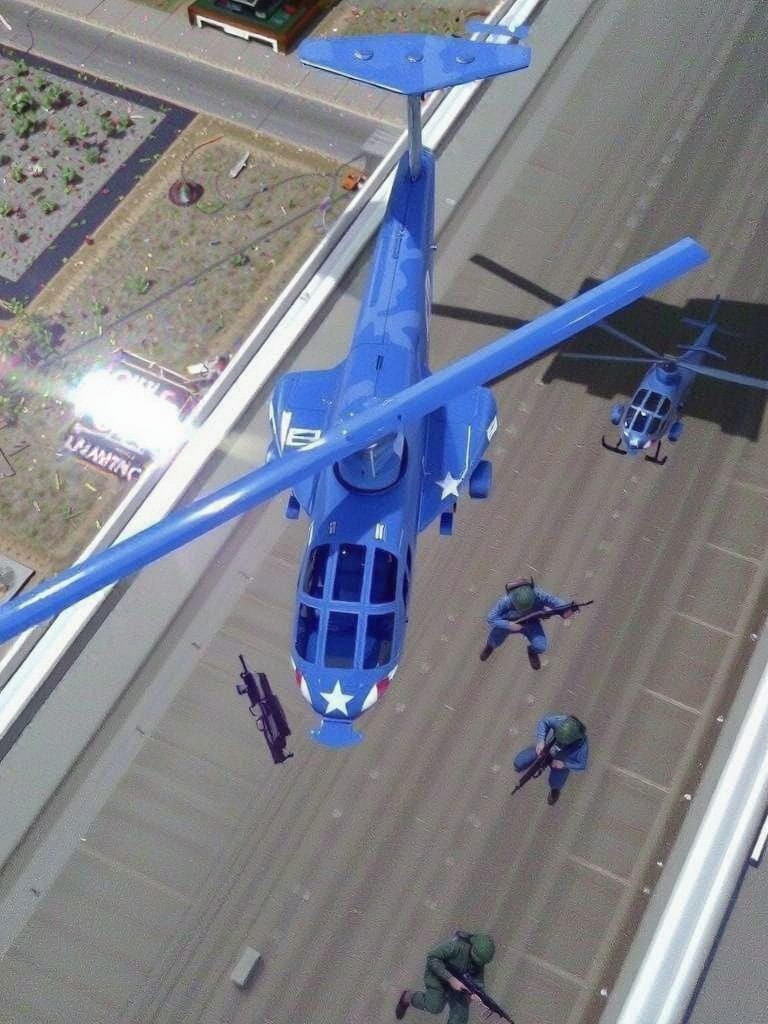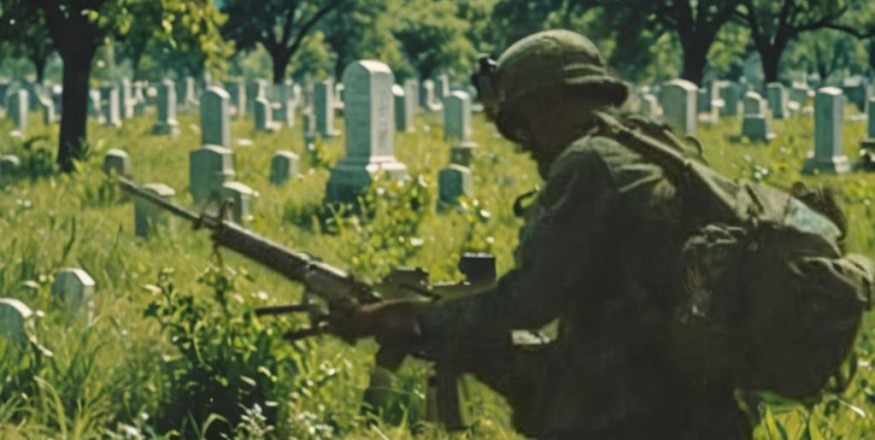 x
x
 The clackety-thud of blades straining at their Jesus nuts had everyone running hot and cold at peak pitch, as nearly 9,000 birds were lost on home soil—to zombie ambushes, to chaotic ground action, to mechanical failure—in the brutal war against the undead. Every grunt and desk jockey from Hicksville to Plainfield stole more than a cursory glance skyward at the ominous thud of an approaching chopper, whether it was a police force skycop, a Huey, a Loach, or a Chinook, each rotor beat echoing the terror of a nation fighting for its very soul.
The clackety-thud of blades straining at their Jesus nuts had everyone running hot and cold at peak pitch, as nearly 9,000 birds were lost on home soil—to zombie ambushes, to chaotic ground action, to mechanical failure—in the brutal war against the undead. Every grunt and desk jockey from Hicksville to Plainfield stole more than a cursory glance skyward at the ominous thud of an approaching chopper, whether it was a police force skycop, a Huey, a Loach, or a Chinook, each rotor beat echoing the terror of a nation fighting for its very soul.Riding on the early morning mists, not knowing if the landing zone was hot or cold despite endless briefings and grease pencils on acetate overlays, the constant military lingo between crew and pilots, the chatter of outgoing '60 fire, hot spent shells, and windrush, and the stark knowledge that if it was a soggy swamp, the water could rise to your thighs, chest, or even above. A panorama of dragonfly-like choppers stuttered into the Z, delivering a pucker factor of F32, as America waged its surreal war against the undead on home soil.
In the heat of the 1960s zombie uprising on U.S. soil, even military helicopters were not spared the undead’s unyielding assault. The shambling horde would sometimes launch themselves at these airborne war machines, crashing into rotor blades and fuselages with horrifying force. Then came the dreaded slamming on metal: if a chopper was hit, its frame would shudder and tear apart, leaving jagged holes that turned the cheap air conditioning into piercing windscreams echoing through the cockpit.
On the ground, amidst the zombie onslaught, there was constant confusion—dust and smoke blanketed unfamiliar American terrain, whether soaked or parched. People moved in frantic, ant-like patterns, all waiting for the relentless surge of undead chaos to finally subside; maybe it would, maybe it wouldn’t, and when the sweltering heat hit, it was oppressively brutal.
On a scorching day in Miami-Dade County, Florida, with temperatures soaring to 105°F in the shade and a sticky 90% humidity hinting at pre-monsoon fury, the battlefield was utterly unforgiving. Amid the relentless zombie onslaught, soldiers scrambled to break free from intense close-range encounters, lugging twenty keys of gear with every weary step. Then, as if by miracle, the air-conditioned luxury of a 1500-foot patrol zone emerged—a fleeting oasis that swept them toward a momentary sense of normalcy after an endless, grueling march through a living nightmare.
Always a thrill to catch a chopper—until that sinking feeling sets in once you're aboard, cursing the ride while envying those lucky enough to enjoy cool air and water all day. There's a profound sense of commitment in diving into the fight against the undead, mixed with bitter regret at being trapped in the chaos. Overhead, military choppers clacked and clicked as all four Corps zigzagged across a scarred, green-brown landscape littered with craters and billowing smoke from shattered towns. They swooped down on missions to rescue a farmer pedaling his old bicycle, to lay down tracer fire around a rundown roadside tavern, or like one pilot I knew who flew at zero feet with his door gunner flat on the floor, taking out rampaging zombies with a trusty .38 special.
In the chaotic American zombie war of the 1960s, the Huey was the taxicab of the fight. You could spend days with one aviation unit running missions all over the nation—extraction runs, rapid responses to squads pinned down by the undead, resupply sorties, and emergency dustoffs; when casualties piled up, some poor souls were forced to remain on the ground. Occasionally, you’d get the thrill of riding a hog gunship—the armored sportscar of the military inventory—though they rarely set you down. I even knew a hog pilot who, fueled by a wild streak, would leave his calling card on every zombie he downed: "The Psychedelic Killer has struck again!" Yet Command never managed to pin down his true identity.



 Sitting in the door gunner's seat of a Huey that had been hit by PIOs from the 25th Division, I found myself drifting over enemy territory near Liberty, Missouri, while below, the rotties swarmed relentlessly. Blue-green tracers from .50-cal rounds zipped toward us, with no extra door gunners aboard—just the pilot and co-pilot. Groping for the 60s twin grip and feeding a belt through made me feel simultaneously useful and foolish; defending that mission was never my call. The PIO just sat there gawking, clueless about door guns. Once, five of us correspondents were mistakenly left two miles from the nearest friendly forces. For an agonizing hour, we waved and shouted at every passing chopper until I finally finished a signal out of my never-used Special Forces survival pack—a boy scout’s must—and an astonished pilot circled once, twice, and ultimately retrieved three majors and two captains, our ranks as correspondents.
Sitting in the door gunner's seat of a Huey that had been hit by PIOs from the 25th Division, I found myself drifting over enemy territory near Liberty, Missouri, while below, the rotties swarmed relentlessly. Blue-green tracers from .50-cal rounds zipped toward us, with no extra door gunners aboard—just the pilot and co-pilot. Groping for the 60s twin grip and feeding a belt through made me feel simultaneously useful and foolish; defending that mission was never my call. The PIO just sat there gawking, clueless about door guns. Once, five of us correspondents were mistakenly left two miles from the nearest friendly forces. For an agonizing hour, we waved and shouted at every passing chopper until I finally finished a signal out of my never-used Special Forces survival pack—a boy scout’s must—and an astonished pilot circled once, twice, and ultimately retrieved three majors and two captains, our ranks as correspondents.
Contour flying was the Grand Prix of the whole war. Coming in from a mission with cornstalks and barbed wire tangled in the skids, each rotor thud sent a red-line jolt through the nerves—you knew you were riding on the seat of your pants, and one tiny mistake meant body bags all around. But staying that low made it harder for a rottie to track you. Hedge-hopping in style, skimming just above the fields and highways, was as close to flying between heaven and hell as it got.
The big choppers could feel like elevators, a sky crane shooting from the ground to 2,500 feet in seconds—stomach lurching, eyes popping, everything hanging on those Jesus nuts. You’d think bigger meant safer—twin-rotored Chinooks, Sea Knights, Sky Cranes—stronger, able to take more hits. But they just came down harder, turning everyone inside into Swiss cheese. Like that run into St. Louis when our Chinook took 60 hits going in. The rotties hit eight choppers in ten minutes that morning, and we barely made it to the edge of the LZ before beating a desperate retreat.
Somehow, when you're wounded, the choppers feel snail-slow, every second stretching like an eternity. The crew chief always says, "Just five more minutes to the med station," but it never feels true. Maybe it's just the pain, the heat, or the weight of knowing how close you came to getting torn apart. The rotor wash feels different when you're bleeding out—like a mirror of your own frail heart, beating against time.
A bringer of life and death, the saving scythe of machine guns cutting through the horde, the pallets of plastic water jerry-cans, half-mashed, dumped into a chain-sawed wasteland—once a quiet Midwestern county, now a no-man’s land. The skyhook dustoff from deep in the Appalachians, where even a flare can’t break through the thick pine cover, where every minute on the ground is borrowed time. The late dusk extract from some crumbling overpass, knowing a miserable night was guaranteed if the birds didn’t make it in time. Then back to a police-run press center filled with Twinkies, Coca-Cola, and the ever-present smell of burnt coffee, gung-ho backslapping for surviving another run, before finally, at last, a little hit of Benny (benzedrine) to keep the nightmares at bay.
We still look up when one clatters overhead. The sound of those rotor blades slicing the air is burned into us, a ghost of the war that never really ended. I’ll always think they make a great camera platform, but an even better frame—a snapshot of chaos, of desperate extractions, of boots dangling over the skids while the dead clawed at the earth below. The heart still flutters at the sound, half nostalgia, half dread, because no matter how many years pass, a chopper in the sky still means someone’s running from something.
























